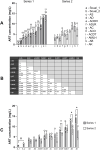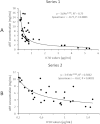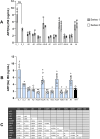Comparison of the composition and antiplasmodial activity of Artemisia annua teas using an untargeted metabolomic approach
- PMID: 40844983
- PMCID: PMC12373170
- DOI: 10.1371/journal.pone.0330682
Comparison of the composition and antiplasmodial activity of Artemisia annua teas using an untargeted metabolomic approach
Abstract
The use of teas made from locally cultivated Artemisia annua to fight malaria in remote areas where access to care is difficult is a matter of debate. This study aimed at document differences in the composition of A. annua teas cultivated in Benin to be sold as antimalarial teas, and in France, and their impact on antiplasmodial activity. A. annua teas were prepared with plants from one location in south France and from ten different plantations in Benin. Artemisinin was quantified in herbal teas with a liquid chromatography system coupled to mass spectrometry and multiple reaction monitoring detection methods. The herbal teas were tested against chloroquine-sensitive 3D7 strain of Plasmodium falciparum using isotopic microtest to determine IC50 values and calculate the concentration of artemisinin corresponding to the IC50 of the teas [ART(tea)_IC50]. Chemical profiles were determined by liquid chromatography coupled to high resolution mass spectrometry and a metabolomic analysis was performed to annotate compounds statistically linked to the antiplasmodial properties of the teas. Artemisinin content varied between 0.3 mg/L for tea with plants from France to 15.7 mg/L for teas made with plants from Benin with differences between locations. Artemisinin content was decreasing after a one-year storage of the plant for 3 localities in Benin with loss of 33%, 48% and 24% (P < 0.05). Artemisinin concentrations and antiplasmodial activity of teas were positively correlated although the comparison of ART(tea)_IC50s to IC50 of pure artemisinin suggested that other compounds present in the tea were involved in the activity, either enhancing or limiting it. Unknown alkaloids in A. annua teas correlated to antiplasmodial activity were also detected. These findings suggest that A. annua teas deserve further studies to identify other metabolites of interest and determine their role in antiplasmodial activity in relation to other molecules, particularly artemisinin.
Copyright: © 2025 Aubouy et al. This is an open access article distributed under the terms of the Creative Commons Attribution License, which permits unrestricted use, distribution, and reproduction in any medium, provided the original author and source are credited.
Conflict of interest statement
The authors have declared that no competing interests exist.
Figures







References
-
- WHO. World malaria report 2024. Geneva, Switzerland: World Health Organization. https://www.who.int/teams/global-malaria-programme/reports/world-malaria...
-
- Ogwang P, Ogwal J, Kasasa S, Olila D, Ejobi F, Kabasa D, et al. Artemisia Annua L. Infusion Consumed Once a Week Reduces Risk of Multiple Episodes of Malaria: A Randomised Trial in a Ugandan Community. Trop J Pharm Res. 2012;11(3). doi: 10.4314/tjpr.v11i3.14 - DOI
Publication types
MeSH terms
Substances
LinkOut - more resources
Full Text Sources

